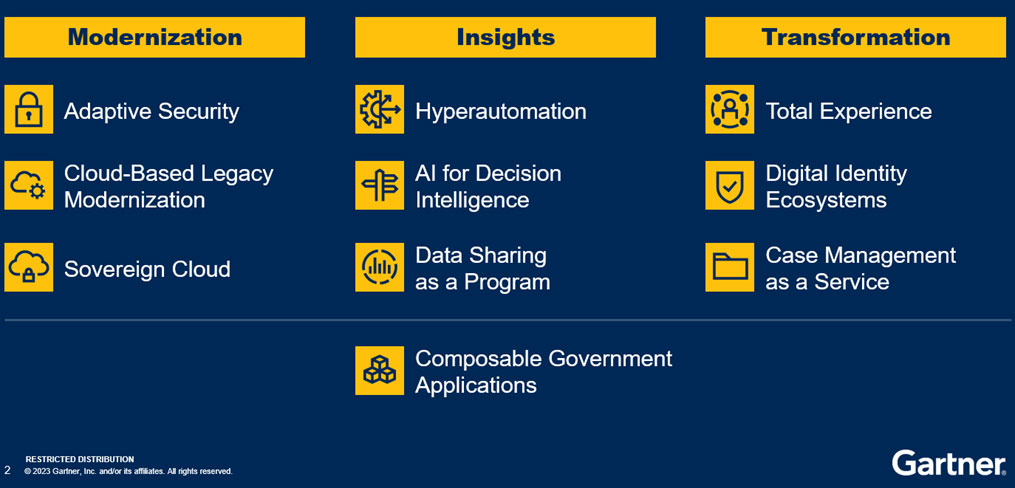CIOs Should Use These Trends to Shape Government Modernization, Insights and Transformation
Gartner, Inc. identified the top 10 government technology trends for 2023 that can guide public sector leaders in accelerating transformation as they prepare for post-digital government and a relentless focus on mission objectives.
“Not only is the current global turmoil and technological disruption putting pressure on governments to find a balance between digital opportunities and risks, it also presents solid opportunities to shape the next generation of digital government,” said Arthur Mickoleit, Director Analyst at Gartner. “Government CIOs must demonstrate their digital investments aren’t just tactical in nature as they continue to improve service delivery and core mission impacts.”
Government CIOs should consider the impact of the following technology trends (see Figure 1) on their organizations and apply insights to make a case for investments to improve business capabilities, achieve leadership priorities and create a more future-ready government organization.
Figure 1: Gartner Top Technology Trends in Government for 2023
 Adaptive Security
Adaptive Security
Gartner predicts that by 2025, 75% of government CIOs will be directly responsible for security outside of IT, including operational and mission-critical technology environments. The convergence of enterprise data, privacy, supply chain, cyber-physical systems (CPS) and cloud requires an integrated security approach. CIOs should link adaptive security to broader digital innovation, transformation, national security and resilience objectives.
Cloud-Based Legacy Modernization
Leading governments are under pressure to break down legacy, siloed systems and data stores to modernize IT infrastructure and applications to ensure more resilient government services. CIOs can use adaptive sourcing strategies to identify areas where “as-a-service” delivery models augment internal resources and address business priorities. Gartner predicts over 75% of governments will operate more than half of workloads using hyperscale cloud service providers by 2025.
Sovereign Cloud
Global uncertainty, as well as concerns over data privacy and potential government overreach, are resulting in greater demand for sovereign clouds. Governments are increasingly seeking to limit exposure of data and infrastructure by external jurisdictions and foreign government access. Gartner predicts over 35% of government legacy applications will be replaced by solutions developed on low-code application platforms and maintained by fusion teams by 2025.
Hyperautomation
According to Gartner, 60% of government organizations will prioritize business process automation by 2026, up from 35% in 2022. Hyperautomation initiatives support business and IT processes in government to deliver connected and seamless citizen services. CIOs must align automation initiatives with current priorities to pursue digital transformation, while also optimizing operational costs.
AI for Decision Intelligence
By 2024, Gartner predicts 60% of government AI and data analytics investments will directly impact real-time operational decisions and outcomes. AI for decision intelligence provides governments with rapid, accurate and early decision-making capabilities at scale. CIOs must prepare for widespread AI use by ensuring data is available at points of decision and by establishing effective governance principles.
Data Sharing as a Program
Data sharing as an ad hoc effort among agencies and departments is no longer sufficient given the demands to drive value from data and analytics. By the end of 2023, Gartner predicts 50% of government organizations will establish formal accountability structures for data sharing, including standards for data structure, quality and timeliness. CIOs should focus on value-added and mission objectives when developing data-sharing initiatives.
Total Experience (TX)
By 2026, government total experience (TX) approaches will reduce process ambiguity by 90%, while increasing satisfaction metrics for both customer experience (CX) and employee experience (EX) by 50%. TX creates synergies and coherence among traditionally siloed disjointed CX, EX, multi-experience (MX) and user experience (UX) disciplines in support of government transformation. CIOs can reduce experience friction points by mapping, visualizing and redesigning citizen and employee journeys.
Digital Identity Ecosystems
Gartner predicts over a third of national governments will offer citizens mobile-based identity wallets by 2024. Governments are facing new responsibilities in emerging digital identity ecosystems, with expectations to ensure trust, innovation and adoption across sectors and borders. To achieve this, governments must make high-assurance digital identity easy to obtain and relevant for diverse target groups of end users and service providers.
Case Management as a Service (CMaaS)
The integration of government services depends on designing and developing case management solutions as composable products and services that can be shared across the programs, verticals and levels of government. Gartner predicts that by 2024, agencies using composable case management will implement new features 80% faster than their peers. CIOs should demonstrate how better outcomes, improved collaboration or program integration can be attained.
Composable Government Applications
Governments can successfully break down legacy, siloed systems and data stores by applying a composable architecture. Continuous improvement and modernization can be achieved by adopting a modular approach to application architecture and by exploiting rapid advancements in automation and machine learning.
ผู้บริหารไอที (CIO) ควรใช้เทรนด์เหล่านี้ปรับองค์กรรัฐให้ทันสมัย (Modernization) มีข้อมูลเชิงลึก (Insights) และเปลี่ยนผ่านให้ทันโลก (Transformation)
การ์ทเนอร์เผย 10 แนวโน้มเทคโนโลยีที่มีความสำคัญต่อกิจการภาครัฐในปี 2566 เป็นแนวทางให้ผู้นำองค์กรภาคสาธารณะเร่งกระบวนการเปลี่ยนผ่านและเตรียมพร้อมไปสู่รัฐบาลหลังยุคดิจิทัล (หรือ Post-Digital Government) และมุ่งที่เป้าหมายของภารกิจทั้งหลายอย่างต่อเนื่อง
อาร์เธอร์ มิคโคลีท ผู้อำนวยการฝ่ายวิจัย การ์ทเนอร์ กล่าวว่า “ความวุ่นวายทั่วโลกและการหยุดชะงักทางเทคโนโลยีในปัจจุบันไม่เพียงแต่กำลังกดดันรัฐบาลให้ต้องหาทางออกเพื่อปรับสมดุลระหว่างโอกาสและความเสี่ยงทางดิจิทัลเท่านั้น แต่ยังให้โอกาสสำคัญอีกหลายอย่างสำหรับเปลี่ยนแปลงรัฐบาลดิจิทัลไปสู่ยุคถัดไป ซึ่งผู้บริหารไอทีภาครัฐฯ ต้องแสดงให้เห็นว่าการลงทุนดิจิทัลของพวกเขานั้นไม่ได้เป็นเพียงแค่กลยุทธ์ทั่ว ๆ ไป ในขณะที่ยังต้องเดินหน้าปรับปรุงการส่งมอบบริการและรับมือกับผลกระทบต่าง ๆ ที่มีต่อภารกิจหลัก”
ผู้บริหาร CIO ภาครัฐฯ ควรพิจารณาผลกระทบของแนวโน้มเทคโนโลยีต่อไปนี้ (ดูรูปที่ 1) ที่มีต่อองค์กร และนำมาปรับใช้เป็นข้อมูลเชิงลึกเพื่อพิจารณารูปแบบการลงทุนพร้อมปรับปรุงความสามารถทางธุรกิจ บรรลุภารกิจสำคัญของผู้นำและสร้างองค์กรรัฐที่พร้อมสำหรับอนาคตยิ่งขึ้น
รูปที่ 1 แนวโน้มเทคโนโลยีภาครัฐ ประจำปี 2566 โดยการ์ทเนอร์
 Adaptive Security
Adaptive Security
การ์ทเนอร์คาดว่า ในปี 2568 75% ของผู้บริหาร CIO ในองค์กรภาครัฐจะมีหน้าที่รับผิดชอบโดยตรงต่อการรักษาความปลอดภัยนอกเหนือจากในส่วนที่เกี่ยวข้องกับไอที ประกอบด้วยเทคโนโลยีด้านความปลอดภัยของการปฏิบัติงานต่าง ๆ รวมถึงเทคโนโลยีที่แวดล้อมภารกิจสำคัญขององค์กร การผสานรวมข้อมูลองค์กร ความเป็นส่วนตัว ซัพพลายเชน ระบบไซเบอร์และกายภาพ (Cyber-Physical Systems หรือ CPS) และระบบคลาวด์ที่มีการรักษาความปลอดภัยอย่างบูรณาการ โดยผู้บริหาร CIO ควรเชื่อมโยง Adaptive Security ให้มีขอบเขตกว้างขึ้นไปถึงนวัตกรรมดิจิทัล การทำดิจิทัลทรานส์ฟอร์เมชัน ภารกิจด้านความมั่นคงของชาติ และเป้าหมายในการสร้างความยืดหยุ่นขององค์กรมากยิ่งขึ้น
Cloud-Based Legacy Modernization
รัฐบาลของประเทศที่เป็นผู้นำอยู่ในความกดดันให้รื้อระบบเก่า ระบบแบบไซโลต่าง ๆ และการจัดเก็บฐานข้อมูล เพื่อปรับปรุงโครงสร้างพื้นฐานไอทีและแอปพลิเคชันให้ทันสมัย รวมถึงเพื่อให้มั่นใจว่าบริการภาครัฐมีความยืดหยุ่นมากขึ้น CIO สามารถใช้กลยุทธ์การจัดหาที่ยืดหยุ่นหรือปรับเปลี่ยนได้ (Adaptive Sourcing Strategies) เพื่อระบุขอบเขตที่รูปแบบ “As-A-Service” จะไปช่วยจัดสรรทรัพยากรภายในและจัดลำดับความสำคัญของภารกิจ การ์ทเนอร์คาดว่าภายในปี 2568 กว่าครึ่งของงานที่ต้องทำขององค์กรภาครัฐฯ มากกว่า 75% จะใช้ผู้ให้บริการคลาวด์แบบไฮเปอร์สเกล
Sovereign Cloud
ความปั่นป่วนทั่วโลก ตลอดจนความกังวลเกี่ยวกับความเป็นส่วนตัวของข้อมูลและการเข้าถึงข้อมูลของรัฐบาลที่เกินขอบเขต ส่งผลให้มีความต้องการอธิปไตยบนคลาวด์ (Sovereign Cloud) มากขึ้น รัฐบาลมีความพยายามมากขึ้นเพื่อเข้าถึงข้อมูลที่เปิดเผยในขอบเขตจำกัดและโครงสร้างพื้นฐาน โดยใช้อำนาจศาลและการเข้าถึงข้อมูลของรัฐบาลต่างประเทศ การ์ทเนอร์คาดการณ์ว่า ภายในปี 2568 มากกว่า 35% ของแอปพลิเคชันรัฐรุ่นเก่า ๆ จะถูกแทนที่ด้วยโซลูชันต่าง ๆ ที่พัฒนาด้วยแพลตฟอร์มแอปพลิเคชันแบบ Low-Code และดูแลโดยทีมงานแบบผสมผสาน (Fusion Team)
Hyperautomation
การ์ทเนอร์ ระบุว่าภายในปี 2569 องค์กรภาครัฐ 60% จะให้ความสำคัญกับการพัฒนาระบบอัตโนมัติในกระบวนการทำงานของรัฐ เพิ่มขึ้นจาก 35% ในปี 2565 โดยการริเริ่มโครงการไฮเปอร์ออโตเมชั่น (Hyperautomation) ใหม่ ๆ จะช่วยสนับสนุนการทำงานและกระบวนการไอทีภาครัฐ สำหรับการให้บริการสาธารณะที่เชื่อมต่อและลื่นไหลแก่ประชาชน โดย CIO ต้องจัดแนวคิดโครงการอัตโนมัติใหม่ ๆ ให้สอดคล้องกับความสำคัญในปัจจุบันในการเปลี่ยนผ่านไปสู่ดิจิทัล ขณะเดียวกันยังต้องจัดสรรค่าใช้จ่ายการดำเนินงานได้อย่างมีประสิทธิภาพ
AI for Decision Intelligence
ภายในปี 2567 การ์ทเนอร์คาดการณ์ว่า 60% ของการลงทุนกับเอไอและการวิเคราะห์ข้อมูลของรัฐบาลจะส่งผลโดยตรงต่อการตัดสินใจและผลลัพธ์การปฏิบัติงานแบบเรียลไทม์ โดยเอไอเพื่อการตัดสินใจอย่างชาญฉลาด (AI For Decision Intelligence) ช่วยให้รัฐบาลตัดสินใจได้อย่างรวดเร็ว แม่นยำ ทันท่วงทีในระดับที่เหมาะสม ซึ่ง CIO ต้องพร้อมสำหรับการนำเอไอมาใช้อย่างแพร่หลายโดยตรวจสอบให้มั่นใจว่ามีข้อมูลเพียงพอต่อการตัดสินใจและเป็นไปตามหลักการกำกับดูแลของภาครัฐที่มีประสิทธิภาพ
Data Sharing as a Program
การใช้ข้อมูลร่วมกัน (Data sharing) ระหว่างหน่วยงานต่าง ๆ ขององค์กรภาครัฐ นั้นยังไม่เพียงพอต่อความต้องการสำหรับการนำข้อมูลมาใช้และวิเคราะห์ ภายในสิ้นปี 2566 นี้ การ์ทเนอร์คาดการณ์ว่า 50% ขององค์กรภาครัฐจะจัดตั้งหน่วยงานที่รับผิดชอบภารกิจด้านแบ่งปันข้อมูลอย่างจริงจัง รวมถึงมาตรฐานโครงสร้างข้อมูล คุณภาพและทันเวลา ซึ่ง CIO ควรโฟกัสไปที่เป้าหมายที่เป็นมูลค่าเพิ่มมาและวัตถุประสงค์ของภารกิจในช่วงกำลังพัฒนาโครงการ Data-Sharing
Total Experience หรือ TX
ภายในปี 2569 แนวทางการสร้างประสบการณ์ภาพรวมของรัฐบาล (Total Experience หรือ TX) จะลดความคลุมเครือในกระบวนการทำงานลงถึง 90% ขณะเดียวกันยังเพิ่มมาตรวัดความพึงพอใจทั้งประสบการณ์ของประชาชนหรือผู้ใช้บริการภาครัฐ (CX) และประสบการณ์ของพนักงานหรือข้าราชการ (EX) ขึ้นถึง 50% โดย TX ช่วยสร้างการทำงานร่วมกันและสอดคล้องกันระหว่าง CX, EX, Multi-Experience (MX) และประสบการณ์ผู้ใช้ (UX) ที่แต่เดิมแยกกันอยู่ เพื่อสนับสนุนการทำดิจิทัลทรานส์ฟอร์เมชันของรัฐบาล CIO สามารถช่วยลดแรงเสียดทานของประสบการณ์ต่าง ๆ โดยเชื่อมโยงองค์ประกอบ (Mapping) จำลองภาพเสมือน (Visualizing) และออกแบบการเดินทางของประสบการณ์ (Journeys) แก่ประชาชนและพนักงานเจ้าหน้าที่ขึ้นใหม่
Digital Identity Ecosystems
การ์ทเนอร์คาดว่า ภายในปี 2567 มากกว่า 1 ใน 3 ของหน่วยงานภาครัฐระดับประเทศจะใช้วอลเล็ตแบบระบุอัตลักษณ์บุคคล โดยรัฐบาลกำลังเผชิญกับความรับผิดชอบรูปแบบใหม่ของการระบุอัตลักษณ์ดิจิทัลผ่านระบบนิเวศต่าง ๆ ที่เกิดขึ้นใหม่ (หรือ Emerging Digital Identity Ecosystems) ที่ยังมาพร้อมกับความคาดหวังว่าระบบต้องมีความปลอดภัย มีนวัตกรรมทันสมัย และสามารถนำไปใช้ในภาคส่วนอื่น ๆ รวมถึงการเดินทางข้ามพรมแดน ซึ่งหากภาครัฐต้องการบรรลุเป้าหมายนี้ ต้องทำให้ข้อมูลอัตลักษณ์ดิจิทัลที่มีความสำคัญสูงนี้เข้าถึงได้ง่ายและสอดคล้องกับกลุ่มเป้าหมายหลากหลายที่เป็นผู้ใช้ปลายทางรวมถึงผู้ให้บริการต่าง ๆ
Case Management as a Service (CMaaS)
การบูรณาการของบริการภาครัฐขึ้นอยู่กับการออกแบบและพัฒนาโซลูชั่นการจัดการเป็นกรณี (Case Management) ให้เป็นผลิตภัณฑ์และบริการที่สามารถประกอบรวมกันได้ ที่สามารถแชร์ไปยังโครงการ หน่วยงาน และภาคส่วนในระดับต่าง ๆ ของรัฐบาลได้ การ์ทเนอร์คาดว่าภายในปี 2567 หน่วยงานรัฐฯ ที่ใช้แนวทางการจัดการแบบประกอบกัน (หรือ Composable Case Management) จะปรับใช้ฟีเจอร์ใหม่ได้เร็วกว่าหน่วยงานอื่นที่อยู่ในระดับใกล้เคียงกันถึง 80% โดย CIO ควรแสดงให้เห็นถึงการบรรลุเป้าหมายทั้งในแง่ผลลัพธ์ การทำงานร่วมกัน หรือการใช้โปรแกรมการทำงานได้อย่างผสมผสาน
Composable Government Enterprise
รัฐบาลสามารถประสบความสำเร็จและทลายกรอบการทำงานแบบเก่า ระบบทำงานไซโล และรูปแบบการเก็บข้อมูลได้ โดยใช้สถาปัตยกรรมที่สามารถนำมาประกอบกันได้ (Composable Architecture) ซึ่งการปรับปรุงพัฒนาและเพิ่มความทันสมัยให้กับระบบอย่างต่อเนื่องสามารถทำได้โดยการนำวิธีการแบบโมดูลาร์ (ที่แยกเป็นส่วน ๆ และนำมาประกอบเข้าด้วยกันได้) มาใช้กับสถาปัตยกรรมแอปพลิเคชัน และใช้ความสามารถของระบบอัตโนมัติและแมชชีนเลิร์นนิ่งที่พัฒนารุดหน้าไปอย่างรวดเร็ว
 Adaptive Security
Adaptive Security